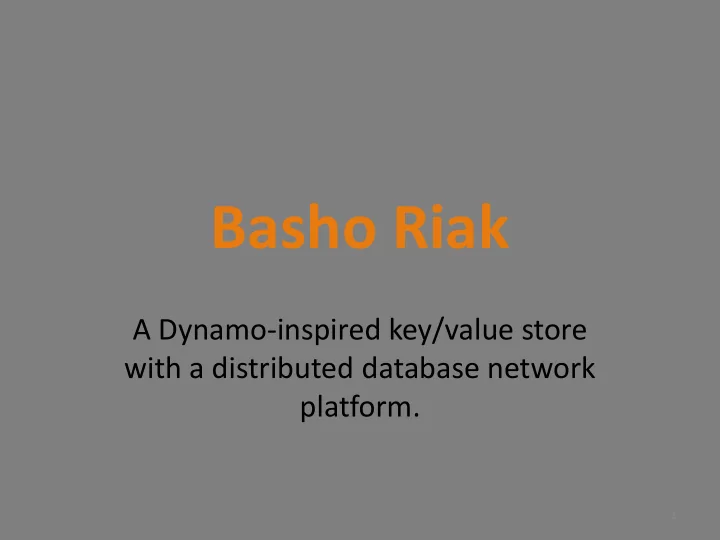

Basho Riak A Dynamo-inspired key/value store with a distributed database network platform. 1
History • Developed by Basho • Sales Force Automation business • Riak more relevant. • Build a business around riak. 2
The Team • Erlang REST framework Webmachine. • Akamai • Eric Brewer (CAP theorem) 3
What is riak? • A document-oriented database • A decentralized datastore • A fault-tolerant storage solution • nosql, http, scalable, distributed, reliable 4
What is riak? • CAP Theorem • Dynamo • The web • Easy ops experience 5
N Value $ curl -v -X PUT -H "Content-Type: application/json" -d '{"props":{"n_val":2}}' \ http://127.0.0.1:8091/riak/REM 6
R Value http:// 127.0.0.1:8091/riak/REM/artist?r = 2 7
W Value $ curl -v -X PUT http://127.0.0.1:8091/riak/docs/story.txt? w = 2 \ -H "Content-type: text/plain" --data-binary @story.txt 8
Partition Tolerance All replicas of the object have the same Vector clock, and therefore the same copy. 9
Riak Handling Inconsistency • There is a network partition. • The left partition is updated. • Partition is removed, Riak will the causally older object. 10
Handling Inconsistency • Both partitions modified the object. • Neither document is more recent. • From riak’s point of view, the wall clock time is uninteresting. • Can not disambiguate between versions. Defer to application. 11
Officially Supported Languages • Erlang • JavaScript • Java • PHP • Python • Ruby • Community contributed projects for .NET, JavaScript, Python (and Twisted), Griffon, Perl, and Scala. 12
REST API • Allows users to manipulate data using standard HTTP methods. – GET – PUT (POST) – DELETE 13
Bucket Operations • List buckets – GET /riak?buckets=true • Read bucket properties and keys – GET /riak/bucket • Set bucket properties like “ n_val ” or “ allow_mult ” – PUT /riak/bucket $ curl -v http://127.0.0.1:8098/riak/test * About to connect () to 127.0.0.1 port 8098 ( #0) * Trying 127.0.0.1... Connected * Connected to 127.0.0.1 ( 127.0.0.1 ) port 8098 ( #0) > GET /riak/test HTTP/1.1 > User-Agent: curl/7.19.7 ( universal-apple-darwin10.0 ) libcurl/7.19.7 OpenSSL/0.9.8l zlib/1.2.3 > Host: 127.0.0.1:809 > Accept: */* > < HTTP/1.1 200 OK < Vary: Accept-Encoding < Server: MochiWeb/1.1 WebMachine/1.7.1 ( participate in the frantic ) < Date: Wed, 14 Jul 2010 18:23:14 GMT < Content-Type: application/json < Content-Length: 368 < * Connection #0 to host 127.0.0.1 left intact * Closing connection #0 { "props": { "name":"test","n_val":3,"allow_mult":false,"last_write_wins":false,"precommit": [] ,"postcommit": [] ," chash_keyfun": { "mod":"riak_core_util","fun":"chash_std_keyfun" } ,"linkfun": { "mod":"riak_kv_wm_link_walker"," fun":"mapreduce_linkfun" } ,"old_vclock":86400,"young_vclock":20,"big_vclock":50,"small_vclock":10,"r":"quor 14 um","w":"quorum","dw":"quorum","rw":"quorum"
Key Operations • Read an object from a bucket – GET /riak/bucket/key • Store new object in bucket – POST /riak/bucket/ (riak-assigned key) – POST /riak/bucket/key (user-defined key) • Delete an object from a bucket – DELETE /riak/bucket/key 15
POST Example $ curl -v -X PUT -d '{"bar":"baz"}' -H "Content-Type: application/json" -H "X-Riak-Vclock: a85hYGBgzGDKBVIszMk55zKYEhnzWBlKIniO8mUBAA==" http://127.0.0.1:8098/riak/test/doc?returnbody =true * About to connect () to 127.0.0.1 port 8098 ( #0) * Trying 127.0.0.1... connected * Connected to 127.0.0.1 ( 127.0.0.1 ) port 8098 ( #0) > PUT /riak/test/doc?returnbody =true HTTP/1.1 > User-Agent: curl/7.19.4 ( universal-apple-darwin10.0 ) libcurl/7.19.4 OpenSSL/0.9.8l zlib/1.2.3 > Host: 127.0.0.1:8098 > Accept: */* > Content-Type: application/json > X-Riak-Vclock: a85hYGBgzGDKBVIszMk55zKYEhnzWBlKIniO8mUBAA == > Content-Length: 13 > < HTTP/1.1 200 OK < X-Riak-Vclock: a85hYGBgymDKBVIszMk55zKYEhnzWBlKIniO8kGF2TyvHYIKfwcJZwEA < Vary: Accept-Encoding < Server: MochiWeb/1.1 WebMachine/1.6 ( eat around the stinger ) < Link: </riak/test>; rel = "up“ < Date: Wed, 10 Mar 2010 17:55:03 GMT < Content-Type: application/json < Content-Length: 13 < * Connection #0 to host 127.0.0.1 left intact * Closing connection #0 { "bar":"baz" } 16
Map Reduce • Increased Data Locality • Take the computation to the data • Map-step – Run map-step functions on the node holding the data for the Map-step. – Sends results back to coordinating node • Reduce-step – Run reduce-step functions on the node coordinating the Map Reduce query 17
Map Reduce 18
Map Reduce • POST operation to map reduce resource • POST –H “content -type: application/json ” http://localhost:8989/mapred --data @- • Body application/json – {“inputs”: […inputs…], “query”: […query…]} – Inputs can be “bucket”, [bucket, key], [bucket, key, keydata] 19
Linking • Link is a HTTP header. • Link: </riak/genre/bluegrass>; riaktag = “listens“ PUT – H Link: </riak/genre/bluegrass>; riaktag = “listens“ \ - H “content - type: text/plain” http://localhost:8989/riak/people/sbz \ - d “bluegrass music” 20
Link Walking 21
Data Storage • Bucket/key pairs • Links and Metadata • Pluggable Backends – Uses API to interact with storage system. – Any thing k/v-shaped works. – Default backend: Bitcast 22
Bitcast Goals • Low latency per read/write • High throughput • Large Data w/o Degradation • Crash Friendliness Brewer proposes hash table log merging. 23
A Bitcast Instance: is basically a directory. Only one file is “active” for writing. All other files closed and immutable. The active file is written by appending a new entry (below). Sequential writes do not require disk seeking. A delete is a simply a write of a tombstone value, which indicates an entry must be removed on the next merge. 24
After an append completes, the “ keydir ” is updated. • keydir is a hash table. • maps every key in a Bitcast to fixed-size structure. • mapping provides file, offset, and size of last written entry. A get( key ) operation. value 25
Applications on Riak • Mozilla Test Pilot is using structured user feedback. – Running Multiple Riak Clusters to gather user data and perform large-scale analysis with MapReduce. – Chose Riak over Cassandra and Hbase because the extensibility; schema changes and bucket creation is completely dynamic. – API: The reliable and heavily tested REST server is built in to riak. – Cost : Light on memory requirements. Decided to use Riak though mozilla is heavily invested in the similar product, HBase. 26
Riak Search • Inverted index of terms to document IDs. • Enable buckets for search integration. • Any objects stored in that bucket will be indexed seamlessly with Riak Search. 27
Recommend
More recommend